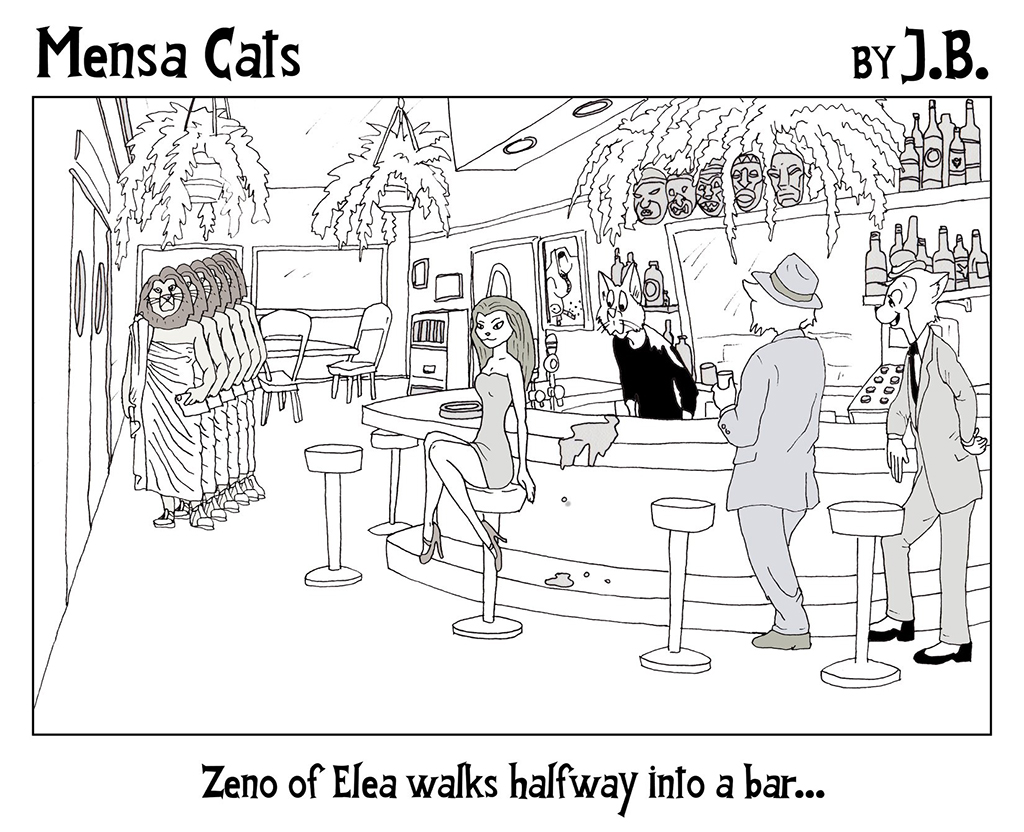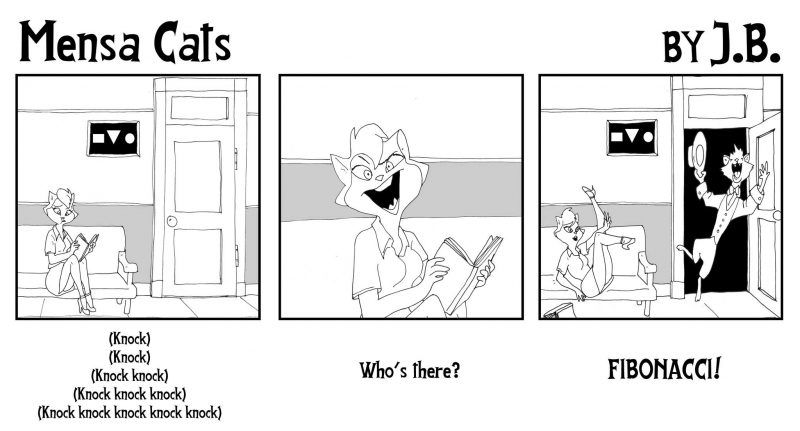Sometimes we like to mix it up on CatSynth TV – just like we used to do here on the blog. This video, on the marine chronometer and its inventor John Harrison, is one of those times. Enjoy!
Mathematics
Mensa Cat Monday: Knock Knock
Mensa Cat Monday: Zeno’s Paradoxes

We bring you a brand new Mensa Cats cartoon by J.B. (that’s Jason Berry of Vacuum Tree Head). This one expresses not one but two of Zeno’s famous paradoxes in a single frame.
The first is the better-known Dichotomy Paradox, from which the punchline derives. In order to walk into the bar, Zeno (or any of the other patrons) must first walk halfway; and to travel from the halfway point, he must travel half of that distance, and then half of that distance, and so on. It seems that this process of walking halfway would continue forever and one would not arrive and one’s destination, yet we know in reality that we do.
The second paradox is the Arrow Paradox. Consider the frame frozen in time, as indicated by the liquid in mid spill behind the young lady cat, or the multiple instances of Zeno along his path. At any given moment, there is no motion. Zeno’s position does change between moment, but there is an infinite number of other frames, each with a fixed position. As copies/frames of Zeno get closer and closer together, the change in time between them gets infinitesimally small. Yet the process 0f adding up these infinite frames with zero motion in each results in Zeno walking halfway into the bar.
The two paradoxes (and the third, commonly referred to as “Achilles and the tortoise”) are closely related. The first deals with infinitesimal subdivisions of space, while the second deals with infinitesimal subdivisions of time. The key is that while any infinitesimal quantity is smaller than any quantity we can express, it is always still greater than zero. And adding up an infinite number of infinitesimal quantities can sometimes yield a finite number.
Take the halving process in the Dichotomy paradox. Zeno moves half this distance, then half of that, and so on. This can be expressed as an infinite sum.

As one gets closer to infinity, the sum gets closer and closer to one. More formally, we can say that as we approach infinity, the sum goes to 1. So an infinite number of subdivisions still reaches our goal of the full distance.
This process of applying operations to an infinite number of infinitesimal subdivisions is the principal behind calculus, and a marvelous thing to behold once one gets used to it. The mathematics does not necessarily answer the metaphysical questions raised by these ancient paradoxes, but it is what most interests us at CatSynth. It’s been a while since we last shared the joy and beauty of mathematics on these pages, but it is high time we resume the practice.
Pi Day Composition Redux
It’s a bit of an on-again-off-again tradition on Pi Day (3-14 in the United States) to share my composition based on the digits of Pi.
It was based on the binary digits rather than decimal digits of Pi, which seemed more universal and also more logical to work with. It uses stretched impulses and square waves for the sounds themselves. At least that is what I recall. It was written in 2011. It’s probably time to revisit the concept with a new piece…
RIP Alphonse Mouzon, Vera Rubin, Carrie Fisher
2016 continues to be a year of losses. Below we visit three people whose work has influenced our diverse interests here at CatSynth and who passed away since this holiday weekend.

[By Dontworry (Own work) [CC BY-SA 3.0], via Wikimedia Commons]
Alphonse Mouzon was one of the important early artists in jazz fusion, and performed with many of our musical heroes, including Herbie Hancock, Wayne Shorter, and Gil Evans. In 1971, he joined Wayne Shorter and the rest of Weather Report for their debut album Weather Report. The band has a mixed history – something we should write about on another occasion – but those first albums in the early 1970s have a sound that were quite influential and resonate with those of us who love jazz fusion of that era. You can hear some Mouzon’s 1971 work with Weather Report in this video:
 Vera Rubin is a name that should be better known that it is in popular culture, as her contributions to cosmology and astronomy are central to our current understanding of the universe. Her work made the case for dark matter and its prevalence in the universe. It was another step in the process of understanding our place in the universe. The earth, then the sun, then the galaxy, all became just small and non-centrals parts in a much larger universe; and the discovery of dark matter showed that the “stuff we are made of”, the ordinary baryonic matter (all the chemical elements and such that we learn about in school) is only a small portion of the mass-energy of the universe. Dark matter has since been eclipsed by dark energy in terms of cosmological composition.
Vera Rubin is a name that should be better known that it is in popular culture, as her contributions to cosmology and astronomy are central to our current understanding of the universe. Her work made the case for dark matter and its prevalence in the universe. It was another step in the process of understanding our place in the universe. The earth, then the sun, then the galaxy, all became just small and non-centrals parts in a much larger universe; and the discovery of dark matter showed that the “stuff we are made of”, the ordinary baryonic matter (all the chemical elements and such that we learn about in school) is only a small portion of the mass-energy of the universe. Dark matter has since been eclipsed by dark energy in terms of cosmological composition.
In addition to the grand perspective, Rubin’s work helped us understand why galaxies like our own Milky Way are shaped the way they are and move the way that they do. She was also a strong advocate for women in science, not just in her own career and field but overall in terms of advocacy in inspiration.

[By Riccardo Ghilardi photographer (Own work) [CC BY-SA 3.0 or GFDL], via Wikimedia Commons]
From great science facts we move to great science fiction. Star Wars is one of the important mythologies in contemporary world, and many of us who saw the original movie in 1977 remember it vividly. While Carrie Fisher was not one of the comedic droids or Darth Vader, her character Princess Leia was important to the story in ways a kindergarten-age kid couldn’t quite fathom at the time. What also makes Fisher particularly interesting is how she presented herself, flaws and all, completely outside of the mythology of Star Wars. She was brutally honest and with a dark, dry sense of humor that came out in real life and in Princess Leia. Indeed, after she reprised the role for Episode VII, she was very up front taking on the trolls who mocked for simply doing what we all do: age. Her semi-autobiographical Postcards from the Edge was an accidental discovery in a video store – I liked seeing women leading a dark story, and only afterwords realized that Fisher wrote the screenplay and the original book.
We at CatSynth send our regards to the families of Alphonse Mouzon, Vera Rubon, and Carrie Fisher; and to all those taken by 2016.





